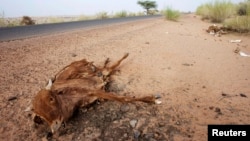UNITED NATIONS —
The United Nations humanitarian coordinator for the Sahel warns that the region, stretching from Senegal to Chad, remains in crisis with more than 11 million people suffering from food insecurity as a result of conflict and drought.
Robert Piper told reporters Tuesday that a strong response to last year’s humanitarian appeal helped improve the situation in Africa’s Sahel region, where 18 million people were food insecure in 2012. But multiple crises - both manmade and natural - have left more than 11 million people in need of assistance this year, including five million children who are at risk of acute malnutrition.
“Beyond Mali’s caseload of internally displaced people and refugees, Chad over in the east, is host to about half a million IDPs and refugees," he said. "In fact, it has seen its largest inflow of people coming across the border from Sudan and from the Central African Republic since 2004 - over the last few months a big surge in new arrivals.
he said, "We have hundreds of thousands of people who have come back, who continue to return from Libya with tremendous consequences for the region in terms of lost income, livelihoods and so forth.”
Piper said the next few months will bring uncertainty for the region. The rainy season is approaching and could bring significant floods, epidemics, locusts and other challenges.
The United Nations has appealed for $1.7 billion to assist the Sahel region this year, but only about a third of those funds - about $600 million - have been received so far.
Piper said there are so many food insecure people in the region despite relatively good rains this year because they are still recovering from the 2012 drought.
“Last year’s drought, we have to remember, came barely two years after the previous one," Piper said. "Crises in this region are becoming more frequent - they are getting closer and closer together. And as a result, people are finding it harder and harder to get back on their feet before the next one comes along.”
In order to help vulnerable communities recover faster, the United Nations is urging donors to close the gap in its 2013 humanitarian appeal.
Robert Piper told reporters Tuesday that a strong response to last year’s humanitarian appeal helped improve the situation in Africa’s Sahel region, where 18 million people were food insecure in 2012. But multiple crises - both manmade and natural - have left more than 11 million people in need of assistance this year, including five million children who are at risk of acute malnutrition.
“Beyond Mali’s caseload of internally displaced people and refugees, Chad over in the east, is host to about half a million IDPs and refugees," he said. "In fact, it has seen its largest inflow of people coming across the border from Sudan and from the Central African Republic since 2004 - over the last few months a big surge in new arrivals.
he said, "We have hundreds of thousands of people who have come back, who continue to return from Libya with tremendous consequences for the region in terms of lost income, livelihoods and so forth.”
Piper said the next few months will bring uncertainty for the region. The rainy season is approaching and could bring significant floods, epidemics, locusts and other challenges.
The United Nations has appealed for $1.7 billion to assist the Sahel region this year, but only about a third of those funds - about $600 million - have been received so far.
Piper said there are so many food insecure people in the region despite relatively good rains this year because they are still recovering from the 2012 drought.
“Last year’s drought, we have to remember, came barely two years after the previous one," Piper said. "Crises in this region are becoming more frequent - they are getting closer and closer together. And as a result, people are finding it harder and harder to get back on their feet before the next one comes along.”
In order to help vulnerable communities recover faster, the United Nations is urging donors to close the gap in its 2013 humanitarian appeal.







